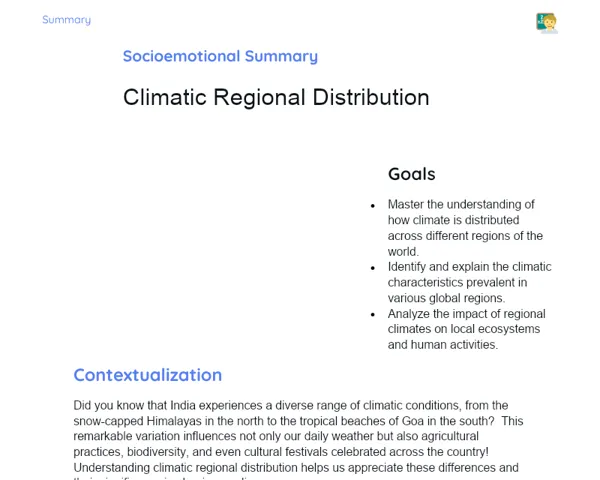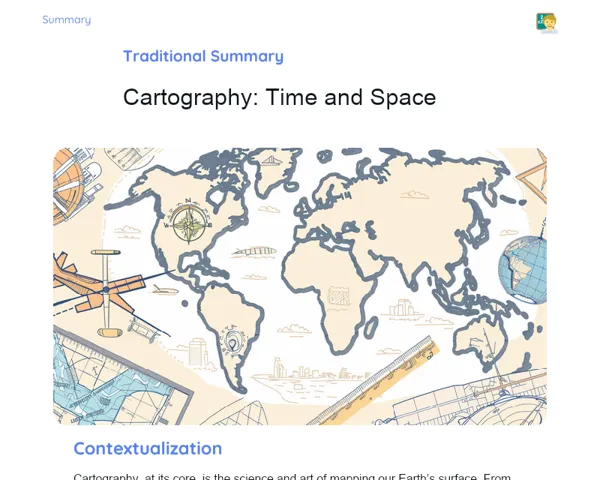Summary Tradisional | America: Indigenous Peoples
Contextualization
The Indigenous peoples of the Americas had been living on the continent for centuries before the Europeans arrived, establishing rich and multifaceted civilisations. These communities had their own languages, religions, forms of governance, and technological skills, underlining a wonderful cultural diversity. Among the prominent Indigenous groups were the Maya, Aztec, Inca, and Tupi-Guarani—each with its own distinct traits and great contributions to the history and culture of the region.
For example, the Maya were renowned for their achievements in astronomy and mathematics, as well as for developing an intricate writing system and calendars. The Aztecs, famous for their capital Tenochtitlán, were excellent in agriculture through the use of chinampas and carried out elaborate religious rituals that sometimes included human sacrifices. On the other hand, the Incas built a vast network of roads and bridges across their empire and practised efficient terrace farming. In Brazil, the Tupi-Guarani people significantly influenced local culture and language, with many of their words still found in modern Portuguese. The legacy of these civilisations is evident even today in various aspects such as cuisine, traditional healthcare, and art.
To Remember!
Maya
The Maya civilisation thrived in the Mesoamerican region, covering parts of today’s Mexico, Guatemala, Belize, Honduras, and El Salvador. They are celebrated for their advanced architecture, astronomy, mathematics, and writing systems. Their cities, marked by majestic pyramids and temples, continue to impress with their grandeur and intricate designs.
Maya society was well-structured with an elite class consisting of nobles and priests who wielded substantial influence. They devised a hieroglyphic writing system to record historical events, religious rituals, and scientific knowledge—one of the most sophisticated systems known from ancient times.
The Maya also shone in astronomy and mathematics by creating highly precise calendars like the Tzolk'in and the Haab, which were indispensable in organising agricultural and religious activities. These calendars reveal their deep understanding of natural cycles and the movement of celestial bodies.
-
Location: Mesoamerica (covering parts of Mexico, Guatemala, Belize, Honduras, and El Salvador).
-
Architecture: Grand pyramids and temples.
-
Society: A hierarchical structure with nobles and priests.
-
Writing: An advanced hieroglyphic script to document historical and scientific events.
-
Astronomy and Mathematics: Calendars such as the Tzolk'in and the Haab that demonstrate remarkable precision.
Aztec
The Aztecs settled in what is modern-day Mexico, with their capital Tenochtitlán situated in present-day Mexico City. Their society was highly militarised and organised with a complex social structure that placed the emperor at the top, followed by nobles, warriors, merchants, and farmers.
Religion was a central pillar in Aztec life; practices included human sacrifices which they believed were essential to appease the gods and ensure the continuity of the world and fertility of the crops. Their agricultural methods were innovative, particularly the use of chinampas—artificial islands built in lakes to boost crop production.
The Aztecs were also noted for their military campaigns and the expansion of their empire through strategic alliances and battles. Their contribution to art and architecture is still admired, thanks to the impressive temples and sculptures they left behind.
-
Location: Modern-day Mexico.
-
Capital: Tenochtitlán.
-
Social Structure: A system with an emperor, followed by nobles, warriors, merchants, and farmers.
-
Religion: Practices including human sacrifices.
-
Agriculture: Use of chinampas for enhanced farming.
-
Expansion: Known for their military campaigns and empire-building.
Inca
The Inca Empire spread across the Andes region, covering parts of what are now Peru, Ecuador, Bolivia, Argentina, Chile, and Colombia. Cusco served as the empire’s heart, being its political, military, and cultural hub. They constructed an impressive network of roads and bridges known as the Qhapaq Ñan that knit the vast empire together, making administration and communication smoother.
The Incas practised highly efficient agriculture using terrace farming even on challenging mountainous terrains. They grew a range of crops including maize, potatoes, and quinoa. Inca architecture, celebrated for its superb stonework, is epitomised by the iconic city of Machu Picchu, which highlights their advanced engineering skills.
Additionally, the Incas devised a unique counting system called quipu, which used strings and knots to record essential information, such as resource management and taxation.
-
Location: Andes region (including modern-day Peru, Ecuador, Bolivia, Argentina, Chile, and Colombia).
-
Capital: Cusco.
-
Road Network: The extensive Qhapaq Ñan.
-
Agriculture: Notable for terrace farming techniques.
-
Architecture: Stone constructions like Machu Picchu.
-
Counting System: Use of quipu for recording data.
Tupi-Guarani
The Tupi-Guarani peoples resided in regions of today’s Brazil, specifically along the coastal areas and tropical forests. They were well known for their agricultural practices which involved cultivating crops such as cassava, maize, and sweet potatoes. Their society was organised around village life, often led by a chieftain, and built on strong family clan ties.
Deeply rooted in mythology and ritualistic traditions, Tupi-Guarani culture placed a strong emphasis on spirituality and a close bond with nature. They revered a host of gods and spirits which influenced everyday life, from farming to conflicts. Their language had a lasting impact on Brazilian Portuguese, with many words still being used in everyday conversation.
The legacy of the Tupi-Guarani is evident not just in language, but also in culinary practices, traditional medicine, and various cultural rituals that continue to be appreciated.
-
Location: Regions in modern-day Brazil.
-
Agriculture: Cultivated cassava, maize, and sweet potatoes.
-
Social Organisation: Village communities led by chieftains and extended family clans.
-
Culture: Rich in mythology, rituals, and spiritual beliefs.
-
Language: Significant impact on Brazilian Portuguese.
-
Legacy: Enduring influences on cuisine, traditional medicine, and cultural practices.
Key Terms
-
Maya: A Mesoamerican civilisation celebrated for its pyramids, astronomy, and advanced writing system.
-
Aztec: A civilisation in modern-day Mexico known for Tenochtitlán, chinampas, and solemn rituals including human sacrifices.
-
Inca: An Andean empire famed for its road network, terrace agriculture, and the quipu counting system.
-
Tupi-Guarani: Indigenous peoples of Brazil recognised for their agricultural methods and noteworthy influence on the region's language and culture.
-
Chinampa: Artificial islands developed by the Aztecs to enhance agriculture.
-
Quipu: A unique Inca system of counting using strings and knots.
-
Tzolk'in and Haab: Calendars developed by the Maya to forecast astronomical events and organise agricultural cycles.
-
Qhapaq Ñan: The extensive road and bridge network engineered by the Incas to connect their empire.
Important Conclusions
The remarkable diversity of Indigenous peoples in the Americas is indeed inspiring, as each civilisation contributed significantly to the cultural fabric of the continent. The Maya, Aztec, Inca, and Tupi-Guarani developed sophisticated systems in writing, agriculture, architecture, and even in administration, leaving behind legacies that remain visible in our everyday lives. Their profound knowledge in fields like astronomy, mathematics, engineering, and spirituality reflected a high level of societal sophistication.
The Maya impressed with their pyramids and impeccably accurate calendars, the Aztecs with their vibrant capital Tenochtitlán and innovative agricultural practices, the Incas with their vast road network and terrace farming, and the Tupi-Guarani with their lasting influence on language and cultural traditions in Brazil. Together, they added vibrancy to the historical and cultural narrative of the Americas, with their contributions still cherished today.
Studying these peoples not only deepens our understanding of American history, but also underscores the importance of Indigenous cultures in shaping modern society. By appreciating and learning from their achievements, we foster respect for cultural diversity and encourage ongoing research and dialogue on this fascinating subject.
Study Tips
-
Revisit the key topics discussed in class and keep detailed notes on each Indigenous group, especially noting their cultural and technological milestones.
-
Watch documentary videos and explore additional resources on the Maya, Aztec, Inca, and Tupi-Guarani to gain a clearer insight into their rich traditions and legacies.
-
Develop a mind map linking the learned information with everyday examples, such as traditional foods, words, and farming techniques that have survived till today.


